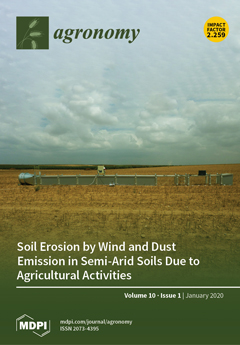Alfalfa is one of the most important, nutritive, and high yielding forage legumes planted across the US. Fall dormancy in alfalfa influences forage yield characteristics and the plants persistence mostly under the cold and temperate climate. The objective of this study was to
[...] Read more.
Alfalfa is one of the most important, nutritive, and high yielding forage legumes planted across the US. Fall dormancy in alfalfa influences forage yield characteristics and the plants persistence mostly under the cold and temperate climate. The objective of this study was to evaluate alfalfa cultivars with different fall dormancy-ratings for their forage yield at each cut and the annual forage yield. Two sets of 24 alfalfa cultivars were evaluated in a field experiment conducted at the Agricultural Science Center at Farmington, NM. The first set of 24 cultivars was planted late fall 2007 at seeding rate of 22.4 kg ha
−1 and managed for the 2007–2011 period and the second set was planted late fall 2009 and managed during the 2009–2013 period. Average forage yield varied with years from 7.6 to 2.9 Mg ha
−1, 6.8 to 4.3 Mg ha
−1, 9.2 to 4.2 Mg ha
−1, and 7.9 to 3.2 Mg ha
−1 during the 1st, 2nd, 3rd, and 4th alfalfa cut, respectively. The results showed no statistical differences between the moderately dormant, dormant, and the non-dormant alfalfa cultivars while they showed higher forage yield than the very dormant and semi-dormant alfalfa cultivars. There was a decreasing trend in forage yield from the first cut to the fourth cut in each growing season. However, the very dormant cultivars showed the lowest forage yield. Alfalfa forage yield decreased from the cut 1 to the cut 4 which represented on average 33, 29, 22, and 16% of the annual yield. The semi-dormant cultivars obtained the lowest forage yield at the first and second cutting while there was no difference between the cultivars for the third and fourth harvests. Average forage yields per harvest were 5.7, 5.9, 6.0, 5.5, and 5.9 Mg ha
−1 for the very dormant, dormant, moderately dormant, semi-dormant, and non-dormant alfalfa cultivars, respectively. Annual forage yield varied with alfalfa fall dormancy-ratings and ranged from 15.5 to 29.9 Mg ha
−1 with the highest forage yield achieved during the third years of the production. The moderately dormant and the non-dormant cultivars showed the highest yield during the first harvest year while the very dormant cultivars and dormant cultivars had the lowest forage yield. Alfalfa cultivars with a fall dormancy range 4–5 may be considered for alfalfa production in northwest New Mexico however, the good agricultural practices (conservation tillage, fertilizer management based on soil residual available nutrient and crop requirement, recommended planting rate, weed and pest management, irrigation scheduling to match crop evapotranspiration) should be the most important to maximize alfalfa forage yield in the southwest US.
Full article





